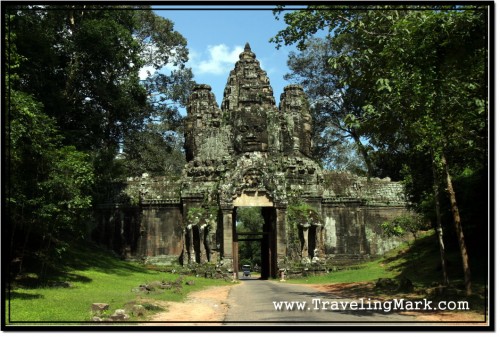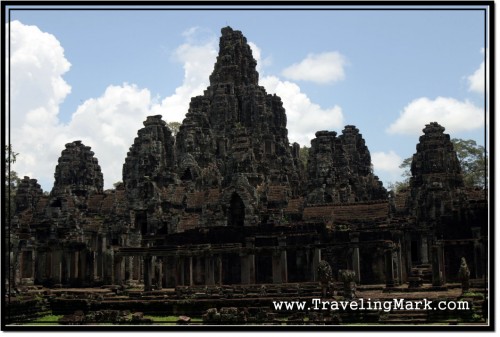Angkor Thom means “Great City” in Khmer language. Covering the area of 9 kilometres squared, the royal city of Angkor Thom was the last capital of the Angkorian Empire. Completely surrounded by wall and moat that’s almost 3 kilometres long on each side, there are five entrance gates to the royal city – one at each cardinal point and the Victory Gate which connected the east side with the Royal Palace. Each of the Angkor Thom gates is crowned with four giant faces, similar to those found on Bayon temple.

Angkor Thom as we know today was constructed over the site of earlier temples and was occupied by city people for five centuries. It was brought to its final glory by King Jayavarman VII though construction of Angkor Thom continued to certain degree after his death.
The remodelling to Angkor Thom to its current state started after King Jayavarman VII drove away Chams who sacked the city. The King remodelled what was left of Angkor Thom into an ensemble that represents the Mount Meru with Bayon in its centre and the moat around it representing the sea of milk that encircles the sacred mountain range. It’s a microcosm of the universe.
Archaeologists speculate that during its boom, Angkor Thom had a water system running through the city. River O Khlot may have been branched and have some of its flow diverted to supply the royal city with life supporting water.
King Jayavarman VII also built temples at each corner of Angkor Thom. These temples, known as Prasat Chrung (Shrine of the Angle) contain an architectural element called “stele” which is an upright slab with inscriptions. The south-eastern Prasat Chrung is the only one with a stele containing complete inscription in Sanskrit on all four sides of the slab. Prasat Chrung temples were dedicated to the Bodhisattva Lokesvara, same as Bayon which served as city’s state temple.

Parts of today’s Angkor Thom, the last capital of Angkorian Empire overlap the area of what used to be Yasodharapura – the first capital of Angkorian Empire (9th century). Temples of Baphuon and Phimeanakas which still exist within today’s Angkor Thom were built in previous centuries and were incorporated into the new layout of Angkor Thom by Jayavarman VII.
Following the tradition, the royal palace was built north of the state temple (in this case it was Bayon). There is nothing left of the royal palace but the courtyard and terraces, as dwellings of people, including royalty were built of wood. Stone dwellings were reserved exclusively for the gods.